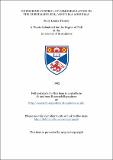Files in this item
Endocrine control of osmoregulation in the euryhaline eel, 'Anguilla anguilla'
Item metadata
| dc.contributor.advisor | Hazon, N. (Neil) | |
| dc.contributor.advisor | Cramb, Gordon | |
| dc.contributor.author | Tierney, Mary Louise | |
| dc.coverage.spatial | 416 p. | en_US |
| dc.date.accessioned | 2018-07-04T15:50:53Z | |
| dc.date.available | 2018-07-04T15:50:53Z | |
| dc.date.issued | 1993 | |
| dc.identifier.uri | https://hdl.handle.net/10023/14936 | |
| dc.description.abstract | 1. Groups of eels, Anguilla anguilla, were adapted from freshwater (FW) to seawater, (SW) for periods of 90 - 300 mins. maximum (acute transfer), 0 - 7 days (chronic transfer), or for more than 14 days (longterm seawater transfer). 2. Acute SW transfer led to a decline in blood pressure, an elevation in plasma osmolality and chloride concentration, an immediate "reflex" drinking response and a non-significant increase in plasma angiotensin II (AH) concentration. 3. Administration of papaverine to FW adapted eel caused hypotension, with subsequent recovery of blood pressure, elevation in the drinking rate and plasma All concentration, and a decline in plasma osmolality. Captopril alone had no effect on blood pressure, drinking rate, osmolality or All concentration, but was successful in partially blocking the papaverine-induced blood pressure recovery and increase in AH concentration, with complete inhibition of the drinking. 4. Administration of papaverine to SW adapted eel caused hypotension, with partial recovery of blood pressure, increased drinking rate, plasma All concentration and plasma osmolality. Captopril alone caused a sustained decrease in blood pressure, inhibition of basal SW drinking and a reduction in plasma All concentration, with change in plasma osmolality. Administration of captopril prior to papaverine was successful in partially blocking the papaverine-induced recovery in blood pressure, increase in drinking, plasma All concentration, and plasma osmolality. 5. Chronic SW transfer led to a general decline in blood pressure, increase in plasma electrolyte concentration, elevation in drinking rate after 4-5 days, an increase in plasma All concentration, and a rise in Na+-K+-ATPase, all leading to long term SW values. 6. Plasma arginine vasotocin concentrations were unchanged in long term-FW and SW adapted fish, with a small transitory rise after 4 days in SW. 7. Cortisol plasma concentrations were similar in both long term- FW and SW- adapted fish, with a rise observed 1 day after transfer to SW. 8. Metabolic clearance rates (MCR) and blood production rates (BPR) were significantly elevated in long term SW adapted fish and during chronic SW adaptation, compared to the FW levels. Binding of 125I-AII to gill (filaments and lamellae), brain (cerebellum and medulla oblongata), kidney (head and caudal), and liver was observed in long term FW and SW adapted fish and 6 day SW transfer animals, with significant increase observed in binding in the caudal kidney and cerebellum and medulla oblongata between the FW group and 6 day SW transfer group. | en_US |
| dc.language.iso | en | en_US |
| dc.publisher | University of St Andrews | |
| dc.subject.lcc | QL638.A55T5 | en |
| dc.subject.lcsh | Anguilla anguilla | en |
| dc.title | Endocrine control of osmoregulation in the euryhaline eel, 'Anguilla anguilla' | en_US |
| dc.type | Thesis | en_US |
| dc.type.qualificationlevel | Doctoral | en_US |
| dc.type.qualificationname | PhD Doctor of Philosophy | en_US |
| dc.publisher.institution | The University of St Andrews | en_US |
This item appears in the following Collection(s)
Items in the St Andrews Research Repository are protected by copyright, with all rights reserved, unless otherwise indicated.

